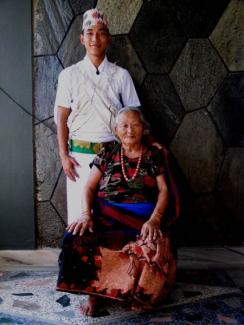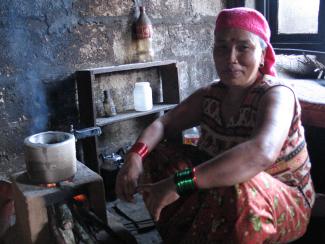Most of Nepal is still very rural, and village life seems to dominates the collective imagination, even of those who now live in large cities such as Kathmandu. Television is becoming more popular. Even traditional mud houses, if they have electricity, often have an old television in the corner.
From my limited, absolutely unscientific survey, it seems that the most popular thing to watch is a Nepali equivalent of MTV. Rather than rock stars in flashy cars, and conspicuous wealth, there is a different scene repeated over and over for these music videos-a mountain hillside with villagers dressed in traditional clothing dancing traditional dances. In houses and businesses I have visited, these videos might play all day long, harkening back to that "simpler time" where everyone was happy and beautiful and danced in perfect harmony with each other. The grind of a typical Nepali city street is a bit different.
Along with these artificial images of traditional life, many elements of real traditional life are treasured and kept alive as well. The woman in the picture lives in Chorepatan, a neighborhood on the outskirts of Pokhara. Her family has built a cement and cinder block house here on the style of any place in the world, dictated by the square lines of the concrete rather than the needs of the family. It has a modern kitchen (by Nepali standards), with a gas stove and refrigerator. But on the roof of the house, the family has built a "traditional house." There is a kitchen/drying room with a smaller and a larger cinder block stove for cooking; a hollow concrete block with two holes, one in the front for feeding in wood and one in the top for the flames to come out. There is no chimney, which accounts for the black patina on the walls. The smoke in the room is used to dry the grain and goat meat hanging from the ceiling. On this roof, "next door" is another room used for sleeping at night and living during the day. (In a traditional house, the other room might be on top of the kitchen.)
For this holiday, the women of the house were cooking traditional food-dried goat meat, cubed and boiled in water-and they were using their traditional kitchen instead of the modern one downstairs.
 Down the street, cousin Rabin Gurung modelled his traditional dress for us, posing for a photograph with his grandmother. She is the matriarch of his house. Families live together in Nepal, with several generations of extended family living together under one roof, and houses passed down through the generations when the oldest generation dies.
Down the street, cousin Rabin Gurung modelled his traditional dress for us, posing for a photograph with his grandmother. She is the matriarch of his house. Families live together in Nepal, with several generations of extended family living together under one roof, and houses passed down through the generations when the oldest generation dies.
Around Rabin's waist is a green British military belt. This has become traditional among the Gurung (Rabin's ethnic group as well as his last name) since many of them have served in the British military, replacing a blue cloth sash like the one his grandmother is wearing.
Music videos from the village, traditional houses built on the roof of an apartment, military belts replacing sashes in native dress-tradition is holding on to a treasured past in a way that works amidst today's realities.
